2014 NISSAN TEANA SEC
[x] Cancel search: SECPage 2415 of 4801
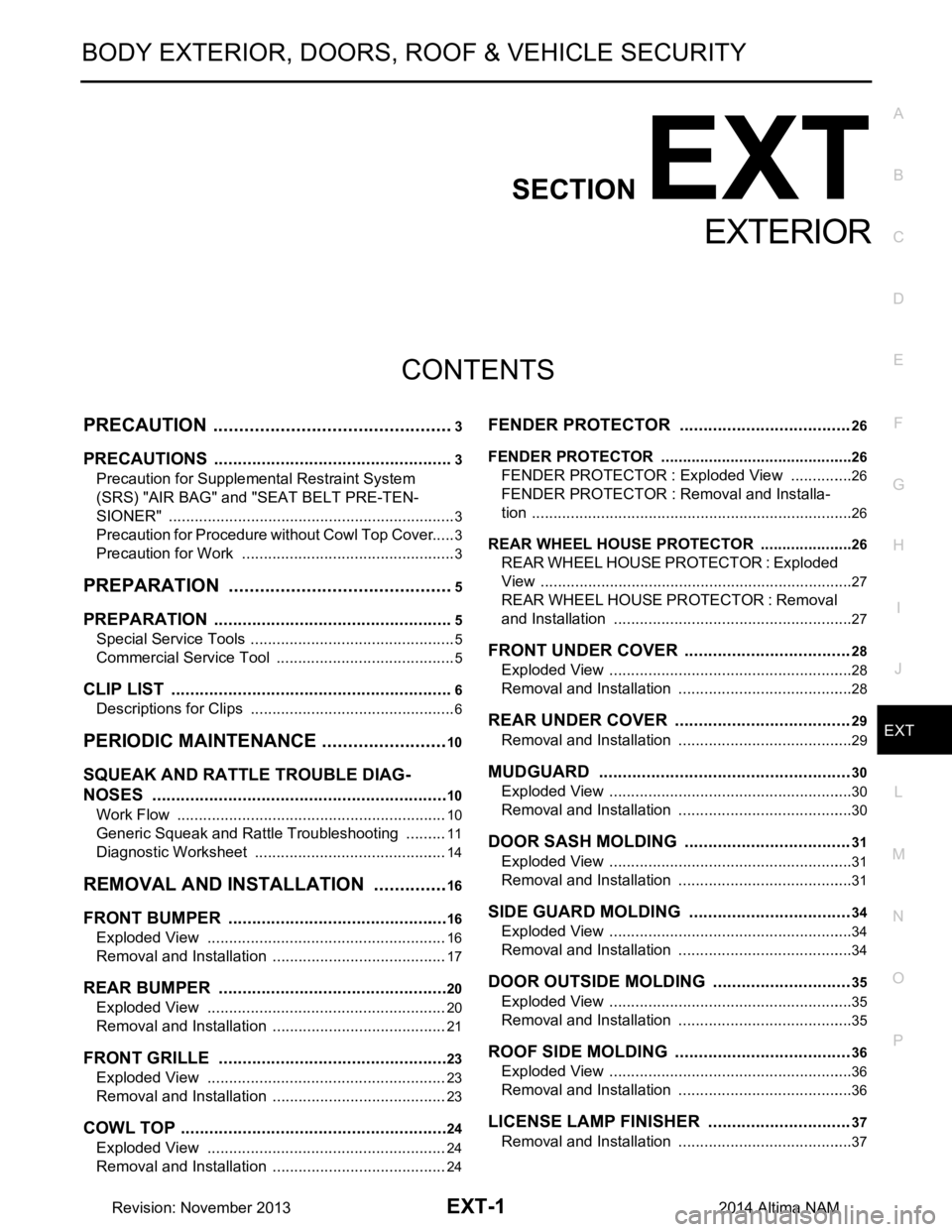
EXT-1
BODY EXTERIOR, DOORS, ROOF & VEHICLE SECURITY
C
D E
F
G H
I
J
L
M
SECTION EXT
A
B
EXT
N
O P
CONTENTS
EXTERIOR
PRECAUTION ................ ...............................3
PRECAUTIONS .............................................. .....3
Precaution for Supplemental Restraint System
(SRS) "AIR BAG" and "SEAT BELT PRE-TEN-
SIONER" ............................................................. ......
3
Precaution for Procedure without Cowl Top Cover ......3
Precaution for Work ..................................................3
PREPARATION ............................................5
PREPARATION .............................................. .....5
Special Service Tools .......................................... ......5
Commercial Service Tool ..........................................5
CLIP LIST ............................................................6
Descriptions for Clips .......................................... ......6
PERIODIC MAINTENANCE .........................10
SQUEAK AND RATTLE TROUBLE DIAG-
NOSES ........................................................... ....
10
Work Flow ........................................................... ....10
Generic Squeak and Rattle Troubleshooting ..........11
Diagnostic Worksheet .............................................14
REMOVAL AND INSTALLATION ...............16
FRONT BUMPER ........................................... ....16
Exploded View .................................................... ....16
Removal and Installation .........................................17
REAR BUMPER ............................................. ....20
Exploded View .................................................... ....20
Removal and Installation .........................................21
FRONT GRILLE ............................................. ....23
Exploded View .................................................... ....23
Removal and Installation .........................................23
COWL TOP ..................................................... ....24
Exploded View .................................................... ....24
Removal and Installation .........................................24
FENDER PROTECTOR ....................................26
FENDER PROTECTOR ......................................... ....26
FENDER PROTECTOR : Exploded View ...............26
FENDER PROTECTOR : Removal and Installa-
tion ....................................................................... ....
26
REAR WHEEL HOUSE PROTECTOR .................. ....26
REAR WHEEL HOUSE PROTECTOR : Exploded
View ..................................................................... ....
27
REAR WHEEL HOUSE PROTECTOR : Removal
and Installation .................................................... ....
27
FRONT UNDER COVER ...................................28
Exploded View .........................................................28
Removal and Installation .........................................28
REAR UNDER COVER .....................................29
Removal and Installation .........................................29
MUDGUARD .....................................................30
Exploded View .........................................................30
Removal and Installation .........................................30
DOOR SASH MOLDING ...................................31
Exploded View .........................................................31
Removal and Installation .........................................31
SIDE GUARD MOLDING ..................................34
Exploded View ..................................................... ....34
Removal and Installation .........................................34
DOOR OUTSIDE MOLDING .............................35
Exploded View .........................................................35
Removal and Installation .........................................35
ROOF SIDE MOLDING .....................................36
Exploded View .........................................................36
Removal and Installation .........................................36
LICENSE LAMP FINISHER ..............................37
Removal and Installation .........................................37
Revision: November 20132014 Altima NAM
Page 2417 of 4801
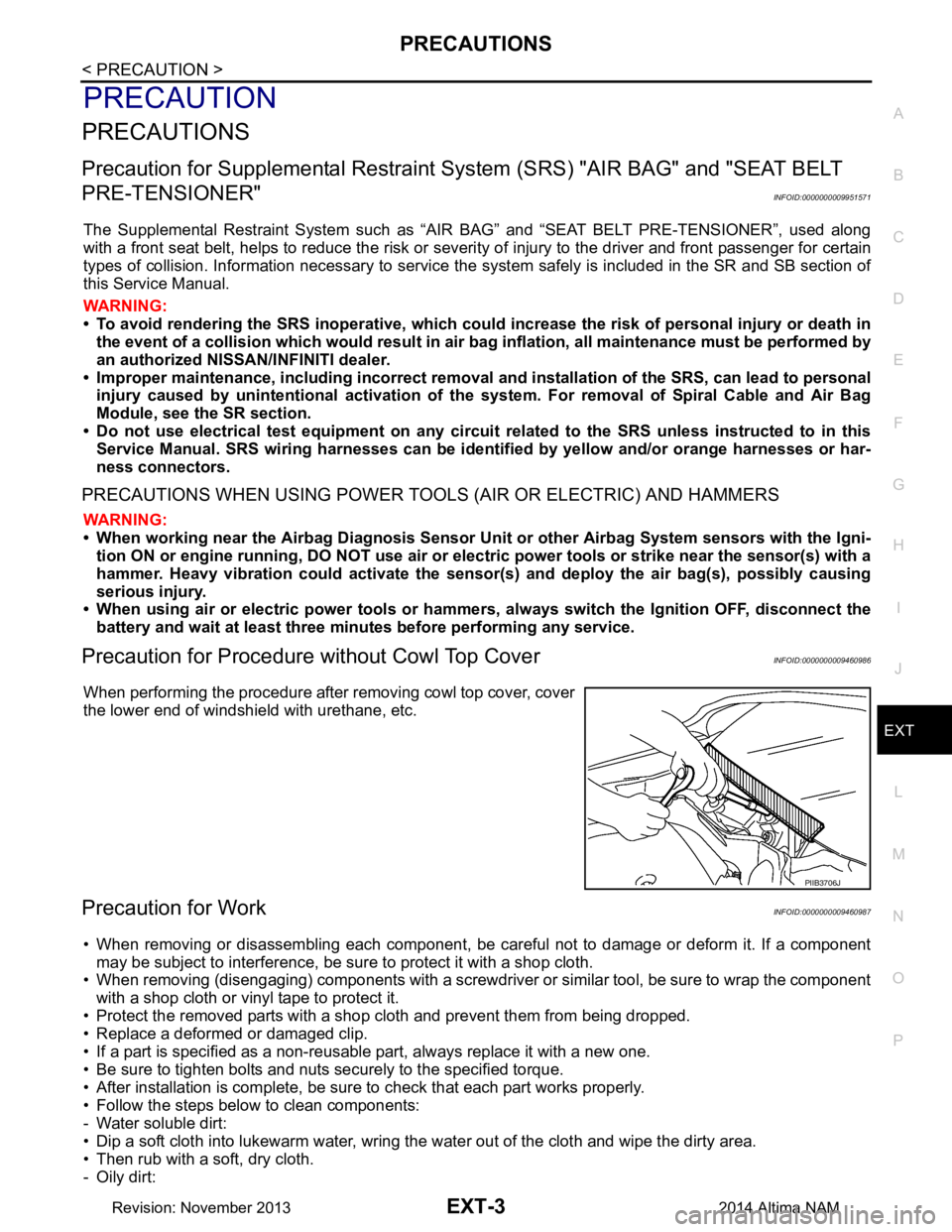
PRECAUTIONSEXT-3
< PRECAUTION >
C
D E
F
G H
I
J
L
M A
B
EXT
N
O P
PRECAUTION
PRECAUTIONS
Precaution for Supplemental Restraint System (SRS) "AIR BAG" and "SEAT BELT
PRE-TENSIONER"
INFOID:0000000009951571
The Supplemental Restraint System such as “A IR BAG” and “SEAT BELT PRE-TENSIONER”, used along
with a front seat belt, helps to reduce the risk or severi ty of injury to the driver and front passenger for certain
types of collision. Information necessary to service t he system safely is included in the SR and SB section of
this Service Manual.
WARNING:
• To avoid rendering the SRS inoper ative, which could increase the risk of personal injury or death in
the event of a collision which would result in air bag inflation, all maintenance must be performed by
an authorized NISSAN/INFINITI dealer.
• Improper maintenance, including in correct removal and installation of the SRS, can lead to personal
injury caused by unintentional act ivation of the system. For removal of Spiral Cable and Air Bag
Module, see the SR section.
• Do not use electrical test equipm ent on any circuit related to the SRS unless instructed to in this
Service Manual. SRS wiring harnesses can be identi fied by yellow and/or orange harnesses or har-
ness connectors.
PRECAUTIONS WHEN USING POWER TOOLS (AIR OR ELECTRIC) AND HAMMERS
WARNING:
• When working near the Airbag Diagnosis Sensor Un it or other Airbag System sensors with the Igni-
tion ON or engine running, DO NOT use air or el ectric power tools or strike near the sensor(s) with a
hammer. Heavy vibration could activate the sensor( s) and deploy the air bag(s), possibly causing
serious injury.
• When using air or electric power tools or hammers , always switch the Ignition OFF, disconnect the
battery and wait at least three mi nutes before performing any service.
Precaution for Procedure without Cowl Top CoverINFOID:0000000009460986
When performing the procedure after removing cowl top cover, cover
the lower end of windshield with urethane, etc.
Precaution for WorkINFOID:0000000009460987
• When removing or disassembling each component, be ca reful not to damage or deform it. If a component
may be subject to interference, be sure to protect it with a shop cloth.
• When removing (disengaging) components with a screwdriver or similar tool, be sure to wrap the component with a shop cloth or vinyl tape to protect it.
• Protect the removed parts with a shop cloth and prevent them from being dropped.
• Replace a deformed or damaged clip.
• If a part is specified as a non-reusabl e part, always replace it with a new one.
• Be sure to tighten bolts and nuts securely to the specified torque.
• After installation is complete, be sure to check that each part works properly.
• Follow the steps below to clean components:
- Water soluble dirt:
• Dip a soft cloth into lukewarm water, wring the water out of the cloth and wipe the dirty area.
• Then rub with a soft, dry cloth.
-Oily dirt:
PIIB3706J
Revision: November 20132014 Altima NAM
Page 2424 of 4801

EXT-10
< PERIODIC MAINTENANCE >
SQUEAK AND RATTLE TROUBLE DIAGNOSES
PERIODIC MAINTENANCE
SQUEAK AND RATTLE TROUBLE DIAGNOSES
Work FlowINFOID:0000000009895307
CUSTOMER INTERVIEW
Interview the customer if possible, to determine the conditions that exist when the noise occurs. Use the Diag-
nostic Worksheet during the interview to document the facts and conditions when the noise occurs and any
customer's comments; refer to EXT-14, "Diagnostic Worksheet"
. This information is necessary to duplicate the
conditions that exist when the noise occurs.
• The customer may not be able to provide a detailed description or the location of the noise. Attempt to obtain
all the facts and conditions that exist w hen the noise occurs (or does not occur).
• If there is more than one noise in the vehicle, be sure to diagnose and repair the noise that the customer is
concerned about. This can be accomplished by test driving the vehicle with the customer.
• After identifying the type of noise, isolate the noise in terms of its characteristics. The noise characteristics
are provided so the customer, service adviser and technician are all speaking the same language when
defining the noise.
• Squeak —(Like tennis shoes on a clean floor) Squeak characteristics include the light contact/fast movement/brought on by road conditions/hard surfaces
= higher pitch noise/softer surfaces = lower pitch noises/edge to surface = chirping.
• Creak—(Like walking on an old wooden floor) Creak characteristics include firm contact/slow mo vement/twisting with a rotational movement/pitch depen-
dent on materials/often brought on by activity.
• Rattle—(Like shaking a baby rattle) Rattle characteristics include the fast repeated contac t/vibration or similar movement/loose parts/missing
clip or fastener/incorrect clearance.
• Knock —(Like a knock on a door) Knock characteristics include hollow sounding/someti mes repeating/often brought on by driver action.
• Tick—(Like a clock second hand) Tick characteristics include gentle contacting of light materials/loose components/can be caused by driver
action or road conditions.
• Thump—(Heavy, muffled knock noise)
Thump characteristics include softer k nock/dead sound often brought on by activity.
• Buzz—(Like a bumble bee) Buzz characteristics include hi gh frequency rattle/firm contact.
• Often the degree of acceptable noise level will vary depending upon the person. A noise that you may judge
as acceptable may be very irritating to the customer.
• Weather conditions, especially humidity and temperat ure, may have a great effect on noise level.
DUPLICATE THE NOISE AND TEST DRIVE
SBT842
Revision: November 20132014 Altima NAM
Page 2425 of 4801
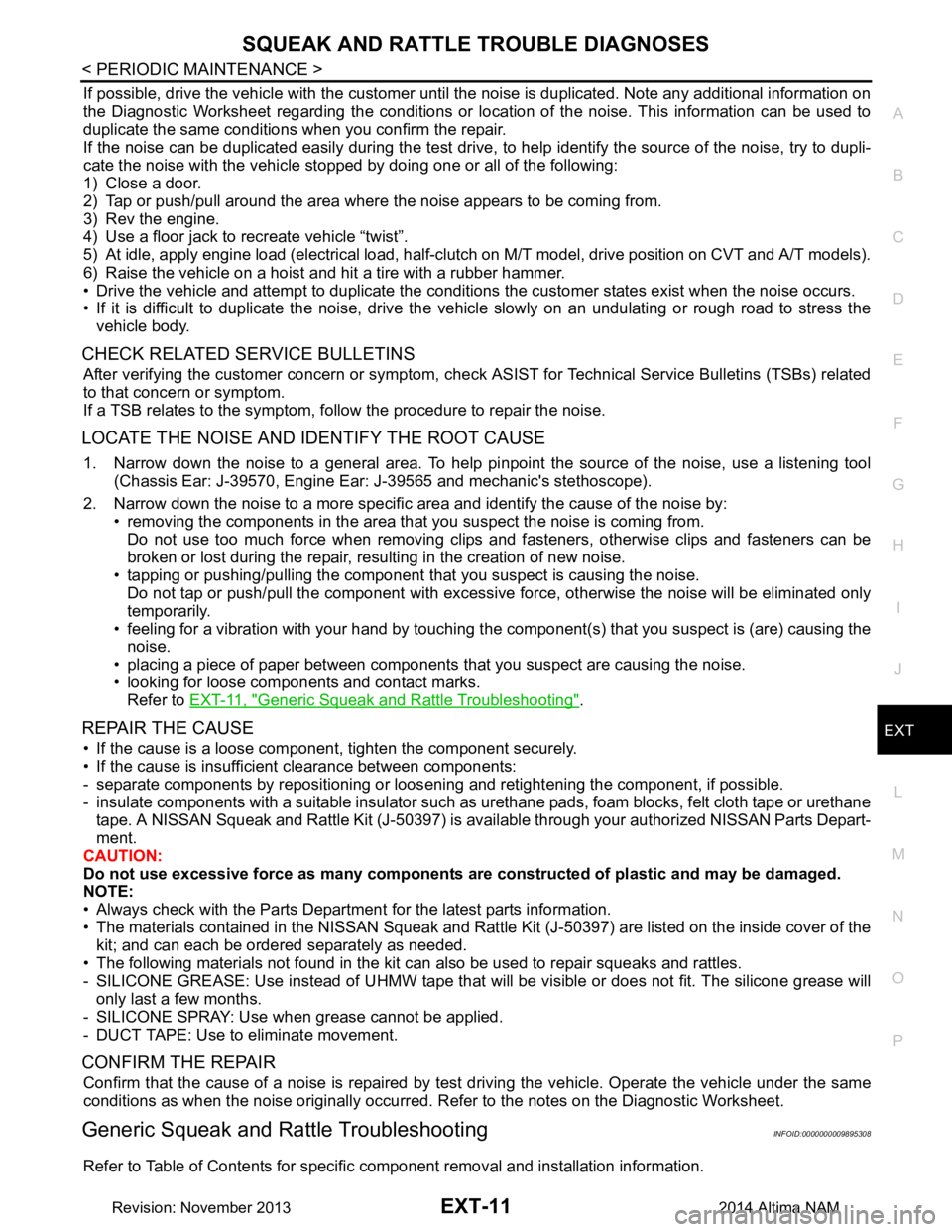
SQUEAK AND RATTLE TROUBLE DIAGNOSESEXT-11
< PERIODIC MAINTENANCE >
C
D E
F
G H
I
J
L
M A
B
EXT
N
O P
If possible, drive the vehicle with the customer until the noise is duplicated. Note any additional information on
the Diagnostic Worksheet regarding the conditions or lo cation of the noise. This information can be used to
duplicate the same conditions when you confirm the repair.
If the noise can be duplicated easily during the test drive, to help identify the source of the noise, try to dupli-
cate the noise with the vehicle stopped by doing one or all of the following:
1) Close a door.
2) Tap or push/pull around the area where the noise appears to be coming from.
3) Rev the engine.
4) Use a floor jack to recreate vehicle “twist”.
5) At idle, apply engine load (electrical load, half-clutch on M/T model, drive position on CVT and A/T models).
6) Raise the vehicle on a hoist and hit a tire with a rubber hammer.
• Drive the vehicle and attempt to duplicate the conditions the customer states exist when the noise occurs.
• If it is difficult to duplicate the noise, drive the vehicle slowly on an undulating or rough road to stress the
vehicle body.
CHECK RELATED SERVICE BULLETINS
After verifying the customer concern or symptom, che ck ASIST for Technical Service Bulletins (TSBs) related
to that concern or symptom.
If a TSB relates to the symptom, follow the procedure to repair the noise.
LOCATE THE NOISE AND IDENTIFY THE ROOT CAUSE
1. Narrow down the noise to a general area. To help pi npoint the source of the noise, use a listening tool
(Chassis Ear: J-39570, Engine Ear: J-39565 and mechanic's stethoscope).
2. Narrow down the noise to a more specific area and identify the cause of the noise by: • removing the components in the area that you suspect the noise is coming from.Do not use too much force when removing clips and fasteners, otherwise clips and fasteners can be
broken or lost during the repair, resulting in the creation of new noise.
• tapping or pushing/pulling the component that you suspect is causing the noise.
Do not tap or push/pull the component with excessive force, otherwise the noise will be eliminated only
temporarily.
• feeling for a vibration with your hand by touching the component(s) that you suspect is (are) causing the
noise.
• placing a piece of paper between components that you suspect are causing the noise.
• looking for loose components and contact marks. Refer to EXT-11, "Generic Squeak and Rattle Troubleshooting"
.
REPAIR THE CAUSE
• If the cause is a loose component, tighten the component securely.
• If the cause is insufficient clearance between components:
- separate components by repositioning or loos ening and retightening the component, if possible.
- insulate components with a suitable insulator such as urethane pads, foam blocks, felt cloth tape or urethane
tape. A NISSAN Squeak and Rattle Kit (J-50397) is av ailable through your authorized NISSAN Parts Depart-
ment.
CAUTION:
Do not use excessive force as many components are constructed of plastic and may be damaged.
NOTE:
• Always check with the Parts Department for the latest parts information.
• The materials contained in the NISSAN Squeak and Rattle Kit (J-50397) are listed on the inside cover of the
kit; and can each be ordered separately as needed.
• The following materials not found in the kit can also be used to repair squeaks and rattles.
- SILICONE GREASE: Use instead of UHMW tape that will be visible or does not fit. The silicone grease will
only last a few months.
- SILICONE SPRAY: Use when grease cannot be applied.
- DUCT TAPE: Use to eliminate movement.
CONFIRM THE REPAIR
Confirm that the cause of a noise is repaired by test driving the vehicle. Operate the vehicle under the same
conditions as when the noise originally occurred. Refer to the notes on the Diagnostic Worksheet.
Generic Squeak and Rattle TroubleshootingINFOID:0000000009895308
Refer to Table of Contents for specific component removal and installation information.
Revision: November 20132014 Altima NAM
Page 2427 of 4801
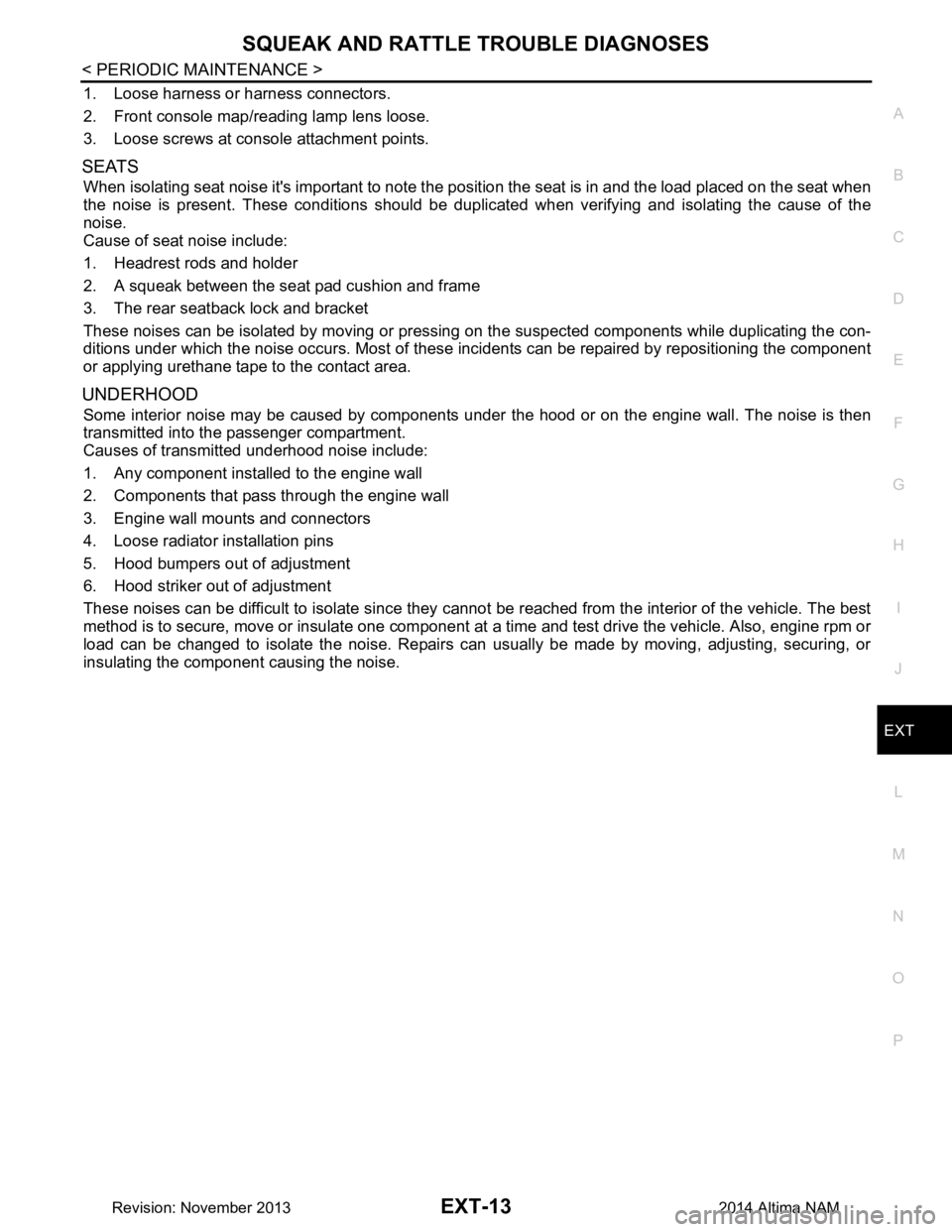
SQUEAK AND RATTLE TROUBLE DIAGNOSESEXT-13
< PERIODIC MAINTENANCE >
C
D E
F
G H
I
J
L
M A
B
EXT
N
O P
1. Loose harness or harness connectors.
2. Front console map/reading lamp lens loose.
3. Loose screws at console attachment points.
SEATS
When isolating seat noise it's important to note the pos ition the seat is in and the load placed on the seat when
the noise is present. These conditions should be duplic ated when verifying and isolating the cause of the
noise.
Cause of seat noise include:
1. Headrest rods and holder
2. A squeak between the seat pad cushion and frame
3. The rear seatback lock and bracket
These noises can be isolated by moving or pressing on the suspected components while duplicating the con-
ditions under which the noise occurs. Most of thes e incidents can be repaired by repositioning the component
or applying urethane tape to the contact area.
UNDERHOOD
Some interior noise may be caused by components under the hood or on the engine wall. The noise is then
transmitted into the passenger compartment.
Causes of transmitted underhood noise include:
1. Any component installed to the engine wall
2. Components that pass through the engine wall
3. Engine wall mounts and connectors
4. Loose radiator installation pins
5. Hood bumpers out of adjustment
6. Hood striker out of adjustment
These noises can be difficult to isolate since they cannot be reached from the interior of the vehicle. The best
method is to secure, move or insulate one component at a time and test drive the vehicle. Also, engine rpm or
load can be changed to isolate the noise. Repairs can usually be made by moving, adjusting, securing, or
insulating the component causing the noise.
Revision: November 20132014 Altima NAM
Page 2433 of 4801
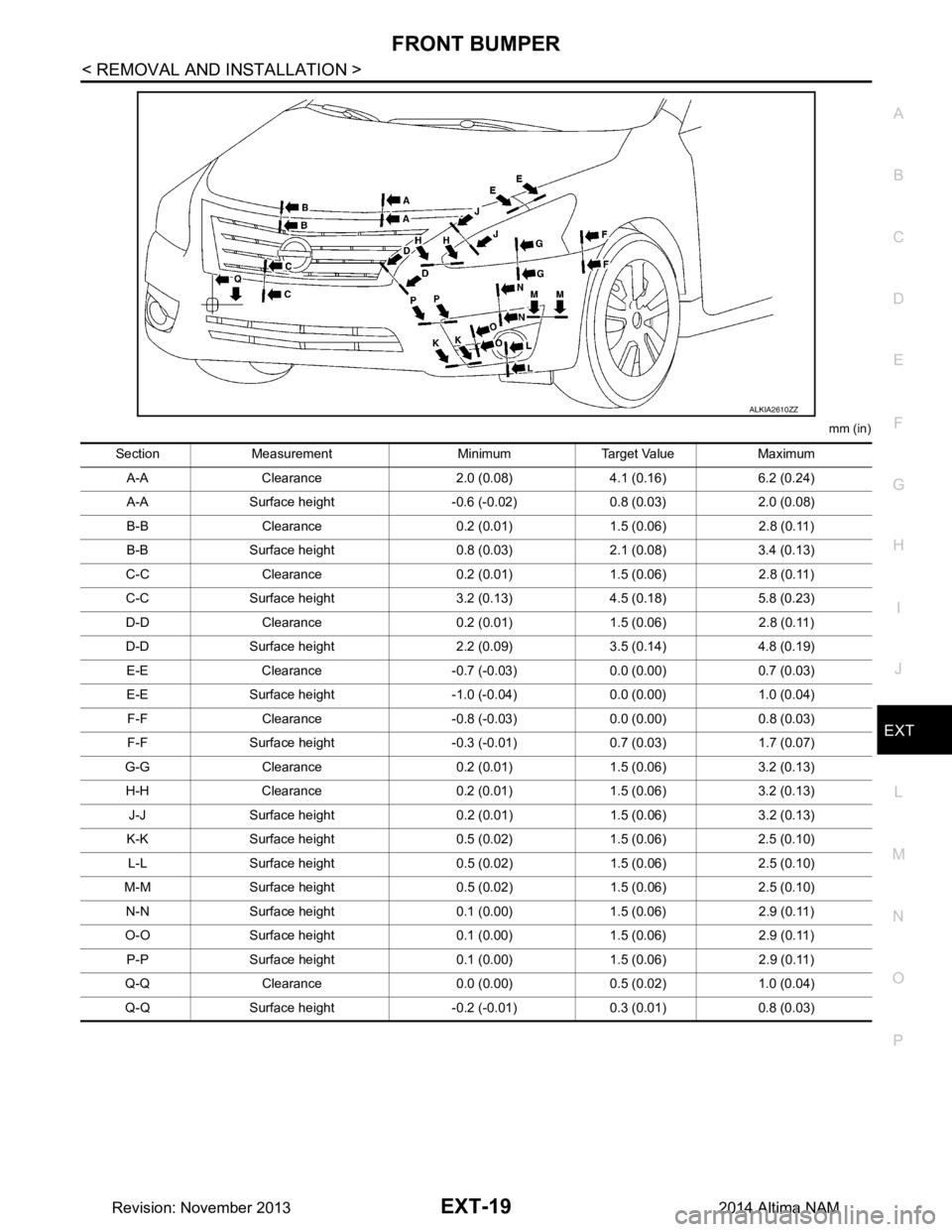
FRONT BUMPEREXT-19
< REMOVAL AND INSTALLATION >
C
D E
F
G H
I
J
L
M A
B
EXT
N
O P
mm (in)
ALKIA2610ZZ
Section Measurement Minimum Target Value Maximum A-A Clearance 2.0 (0.08) 4.1 (0.16) 6.2 (0.24)
A-A Surface height -0.6 (-0.02) 0.8 (0.03) 2.0 (0.08)
B-B Clearance 0.2 (0.01) 1.5 (0.06) 2.8 (0.11)
B-B Surface height 0.8 (0.03) 2.1 (0.08) 3.4 (0.13)
C-C Clearance 0.2 (0.01) 1.5 (0.06) 2.8 (0.11)
C-C Surface height 3.2 (0.13) 4.5 (0.18) 5.8 (0.23)
D-D Clearance 0.2 (0.01) 1.5 (0.06) 2.8 (0.11)
D-D Surface height 2.2 (0.09) 3.5 (0.14) 4.8 (0.19) E-E Clearance -0.7 (-0.03) 0.0 (0.00) 0.7 (0.03)
E-E Surface height -1.0 (-0.04) 0.0 (0.00) 1.0 (0.04) F-F Clearance -0.8 (-0.03) 0.0 (0.00) 0.8 (0.03)
F-F Surface height -0.3 (-0.01) 0.7 (0.03) 1.7 (0.07)
G-G Clearance 0.2 (0.01) 1.5 (0.06) 3.2 (0.13)
H-H Clearance 0.2 (0.01) 1.5 (0.06) 3.2 (0.13) J-J Surface height 0.2 (0.01) 1.5 (0.06) 3.2 (0.13)
K-K Surface height 0.5 (0.02) 1.5 (0.06) 2.5 (0.10) L-L Surface height 0.5 (0.02) 1.5 (0.06) 2.5 (0.10)
M-M Surface height 0.5 (0.02) 1.5 (0.06) 2.5 (0.10) N-N Surface height 0.1 (0.00) 1.5 (0.06) 2.9 (0.11)
O-O Surface height 0.1 (0.00) 1.5 (0.06) 2.9 (0.11) P-P Surface height 0.1 (0.00) 1.5 (0.06) 2.9 (0.11)
Q-Q Clearance 0.0 (0.00) 0.5 (0.02) 1.0 (0.04)
Q-Q Surface height -0.2 (-0.01) 0.3 (0.01) 0.8 (0.03)
Revision: November 20132014 Altima NAM
Page 2436 of 4801
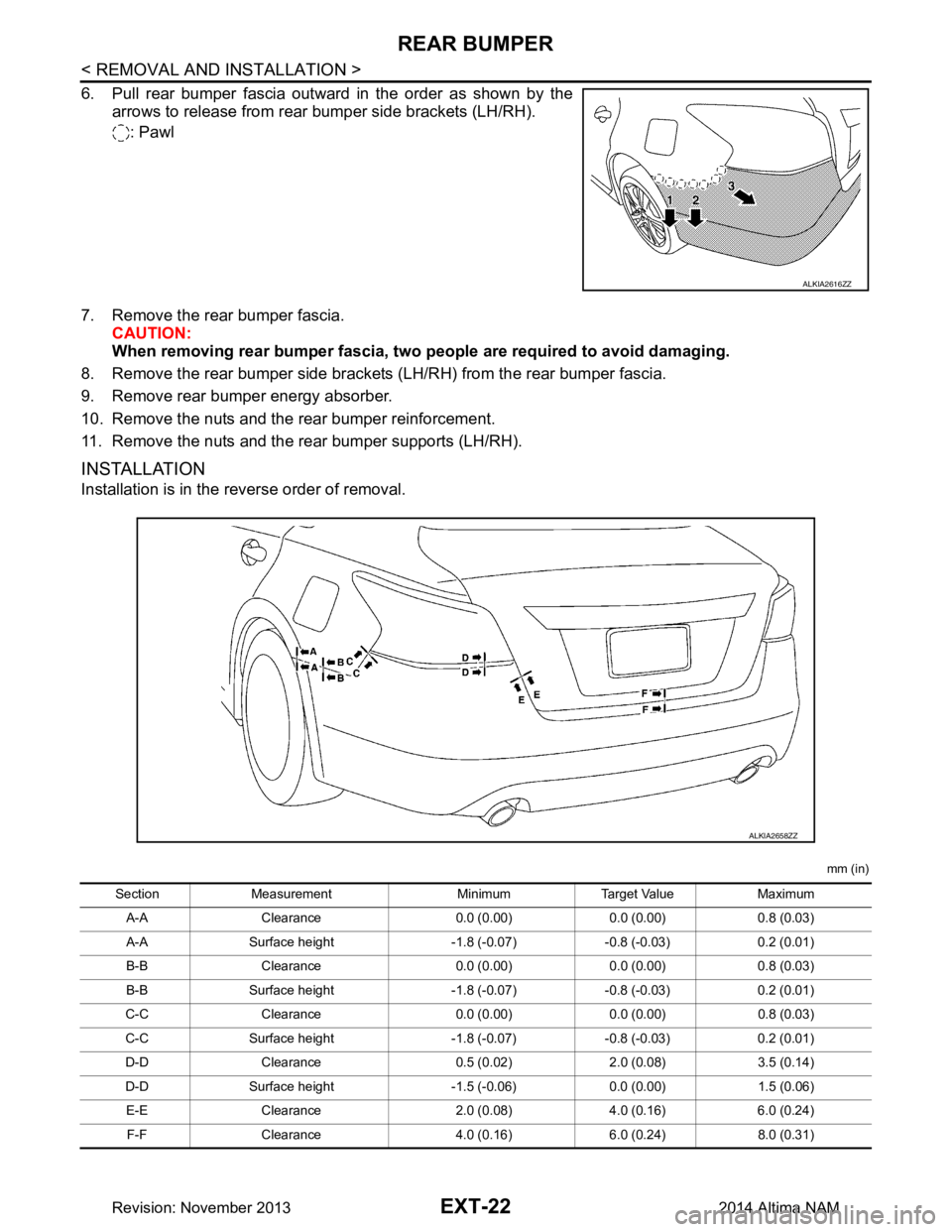
EXT-22
< REMOVAL AND INSTALLATION >
REAR BUMPER
6. Pull rear bumper fascia outward in the order as shown by thearrows to release from rear bumper side brackets (LH/RH).
: Pawl
7. Remove the rear bumper fascia. CAUTION:
When removing rear bumper fascia, two people are required to avoid damaging.
8. Remove the rear bumper side brackets (LH/RH) from the rear bumper fascia.
9. Remove rear bumper energy absorber.
10. Remove the nuts and the rear bumper reinforcement.
11. Remove the nuts and the rear bumper supports (LH/RH).
INSTALLATION
Installation is in the reverse order of removal.
mm (in)
ALKIA2616ZZ
ALKIA2658ZZ
Section Measurement Minimum Target Value Maximum
A-A Clearance 0.0 (0.00) 0.0 (0.00) 0.8 (0.03)
A-A Surface height -1.8 (-0.07) -0.8 (-0.03) 0.2 (0.01)
B-B Clearance 0.0 (0.00) 0.0 (0.00) 0.8 (0.03)
B-B Surface height -1.8 (-0.07) -0.8 (-0.03) 0.2 (0.01)
C-C Clearance 0.0 (0.00) 0.0 (0.00) 0.8 (0.03)
C-C Surface height -1.8 (-0.07) -0.8 (-0.03) 0.2 (0.01)
D-D Clearance 0.5 (0.02) 2.0 (0.08) 3.5 (0.14)
D-D Surface height -1.5 (-0.06) 0.0 (0.00) 1.5 (0.06) E-E Clearance 2.0 (0.08) 4.0 (0.16) 6.0 (0.24)
F-F Clearance 4.0 (0.16) 6.0 (0.24) 8.0 (0.31)
Revision: November 20132014 Altima NAM
Page 2453 of 4801
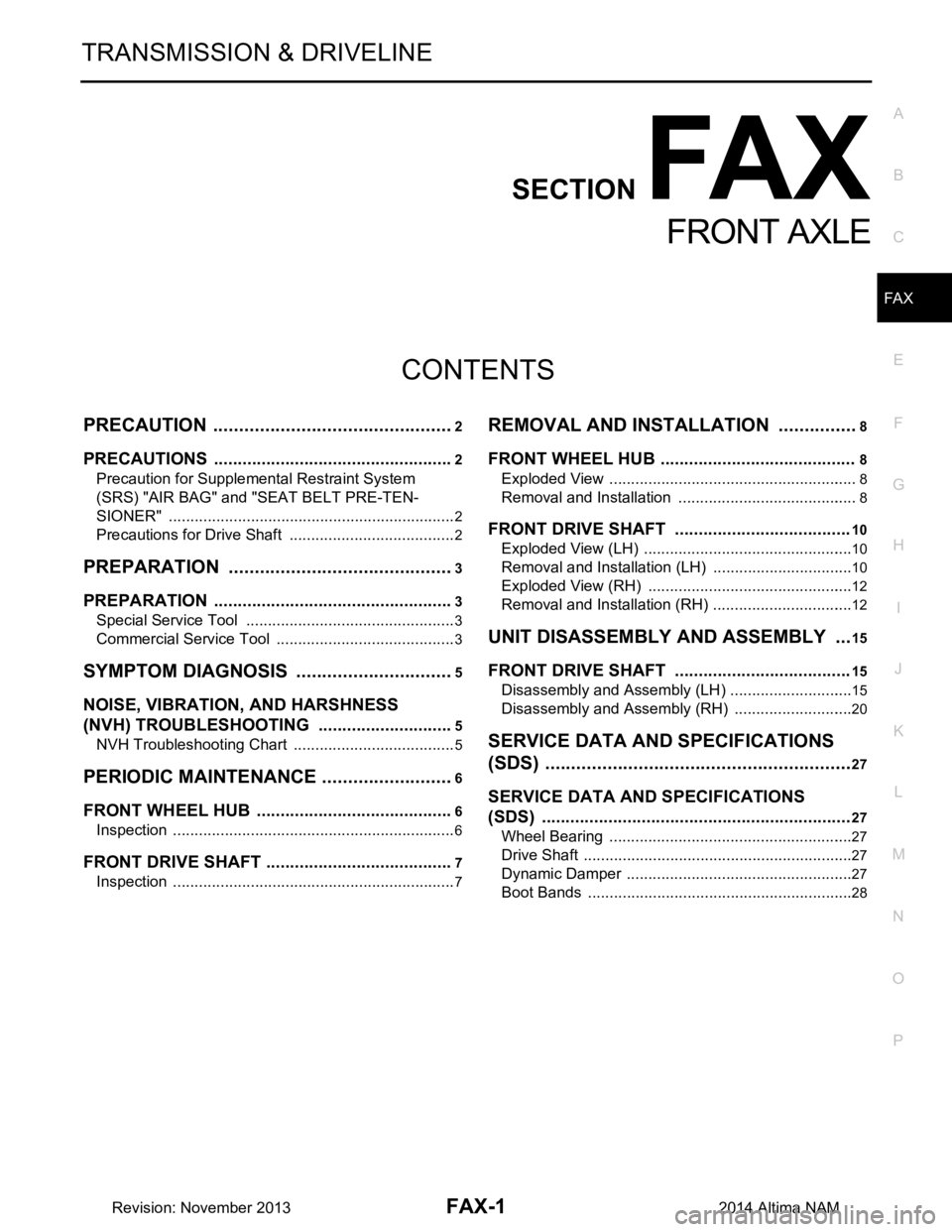
FAX-1
TRANSMISSION & DRIVELINE
CEF
G H
I
J
K L
M
SECTION FA X
A
B
FA X
N
O P
CONTENTS
FRONT AXLE
PRECAUTION ................ ...............................2
PRECAUTIONS .............................................. .....2
Precaution for Supplemental Restraint System
(SRS) "AIR BAG" and "SEAT BELT PRE-TEN-
SIONER" ............................................................. ......
2
Precautions for Drive Shaft .......................................2
PREPARATION ............................................3
PREPARATION .............................................. .....3
Special Service Tool ........................................... ......3
Commercial Service Tool ..........................................3
SYMPTOM DIAGNOSIS ...............................5
NOISE, VIBRATION, AND HARSHNESS
(NVH) TROUBLESHOOTING ........................ .....
5
NVH Troubleshooting Chart ................................ ......5
PERIODIC MAINTENANCE ..........................6
FRONT WHEEL HUB ..................................... .....6
Inspection ............................................................ ......6
FRONT DRIVE SHAFT ........................................7
Inspection ............................................................ ......7
REMOVAL AND INSTALLATION ................8
FRONT WHEEL HUB .........................................8
Exploded View ..................................................... .....8
Removal and Installation ..........................................8
FRONT DRIVE SHAFT .....................................10
Exploded View (LH) .................................................10
Removal and Installation (LH) .................................10
Exploded View (RH) ............................................ ....12
Removal and Installation (RH) .................................12
UNIT DISASSEMBLY AND ASSEMBLY ....15
FRONT DRIVE SHAFT .....................................15
Disassembly and Assembly (LH) ......................... ....15
Disassembly and Assembly (RH) ............................20
SERVICE DATA AND SPECIFICATIONS
(SDS) ............... .............................................
27
SERVICE DATA AND SPECIFICATIONS
(SDS) .................................................................
27
Wheel Bearing ..................................................... ....27
Drive Shaft ...............................................................27
Dynamic Damper .....................................................27
Boot Bands ..............................................................28
Revision: November 20132014 Altima NAM